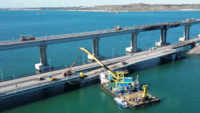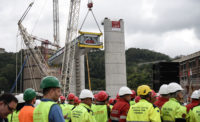Work was completed on the first-ever railroad bridge connecting Russia to China in early April, as Russian engineers installed the final steel beam in its section of the structure over the river called the Amur in Russian and the Heilongjiang. China finished its part of the work last October, as the structure successfully spanned the world's 10th longest river, which markets the boundary between the two countries. Officials say the bridge will open for public use after the necessary inspections in July this year.
Construction of the 2,200-meter bridge linking Nizhneleninskoye in Russia's Jewish Autonomous Oblast and the Chinese city of Tongjiang city began in 2014. Construction of the $355-million bridge, followed 20 years of negotiations and several ups and downs in decision-making between China and Russia.
The span complies with both Chinese and Russia rail bridge standards, and was designed by Russia's Giprostroymost Institute. There are two tracks, a standard gauge (1435 mm) track and a Russian gauge (1520 mm) track. However, only one track will be used at any given time.
The main structure runs north-south and will consist of twenty 110-meter steel through-truss spans. China and Russia have also agreed to construct a two-lane highway bridge over the river to link the “twin” trading cities of Blagoveshchensk and Heihe.
China and Russia also recently signed an agreement to build a Meridian toll highway connecting the two countries. This is an ambitious project for China, part of President Xi Jinping's Belt and Road plan. Announced in 2013 and intended to link China’s western neighbor Kazakhstan with Belarus, it took six years of discussions before Russia agreed to implement the project.
In Russia, the project has been mentioned in the 110-page blueprint on “National Projects” published last February: “By the end of 2024, the Russian section of the Meridian toll highway will be built.”
The new, toll-free four-lane highway will bypass inhabited areas and will be just under 120 km long.
China has begun planning and initial construction work on a 2,000-km-long transcontinental route connecting it to European Union areas including Belarus. It will stretch through Russian territory bordering Kazakhstan and Belarus, senior officials from the Russian Ministry of Transport have said. The Meridian highway will pass through the Sagarchin crossing point on the border of Russia and Kazakhstan. Reports quoting Russian government officials said that construction has has already started on the route in the Orenburg District around the Sagarchin border crossing point.
Within Russia, one section of the highway connecting its European part at the M-4 “Don” highway in the country’s European part to Sochi, one of Russia’s top tourist destinations, will stretch 210 kms. Construction work on this section involves 43 bridges and over-crossings and 27 tunnels.
The Russian investment holding LLC Meridian, co-owned by businessmen Alexander Ryazanov and Roman Nesterenko, is implementing the project, according to reports.
In his speech at the recent Belt and Road Forum in Beijing, Russian President Vladimir Putin proposed an integration between different programs and institutions like the Russia-backed Eurasian Economic Union (EAEU), the Association of South East Asian Nations (ASEAN), the Shanghai Cooperation Organization and One Belt, One Road (now called the Belt and Road Initiative).
Putin also indicated that Russian cooperation is essential to overcome challenges to BRI in the Eurasian region.
In his speech, Putin said, “it is necessary to eliminate infrastructure restrictions for integration – mainly by creating a system of modern and well-connected transport corridors. Russia with its unique geographic location is willing to engage in this joint activity.”
London to Tokyo
Another bridge project proposal would make it possible to make the dream train journey from London to Tokyo after passing, for the most part, through Russia. Russia recently announced plans to construct a 45-km-long bridge through the East Sea to connect with Japan. If successful, it would make a rail connection possible from London, through Russia to Tokyo.
Russia has already approach Japan with the proposal. The new route will cover Germany and Eastern Europe and the Siberian Mountains before passing over the East Sea to Japan.
“We are seriously offering Japanese partners to consider the construction of a mixed road-and-railway passage from Hokkaido to southern part of Sakhalin,” said Russia's First Vice-Premier Igor Shuvalov.
“At the same time, we are close to starting our part of the job, which is extending the railway to the Pacific shore and the construction of passage of the same complexity from mainland to Sakhalin,” he said.
At present, the Trans-Siberian line ends in Vladivostok. Under the new proposal, the line will go east from the Russian mainland to the Pacific island of Sakhalin, and from there to Hokkaido, where it would link with the Japanese rail network.
“Given modern technologies, it is not even that expensive,” the minister said.




Post a comment to this article
Report Abusive Comment